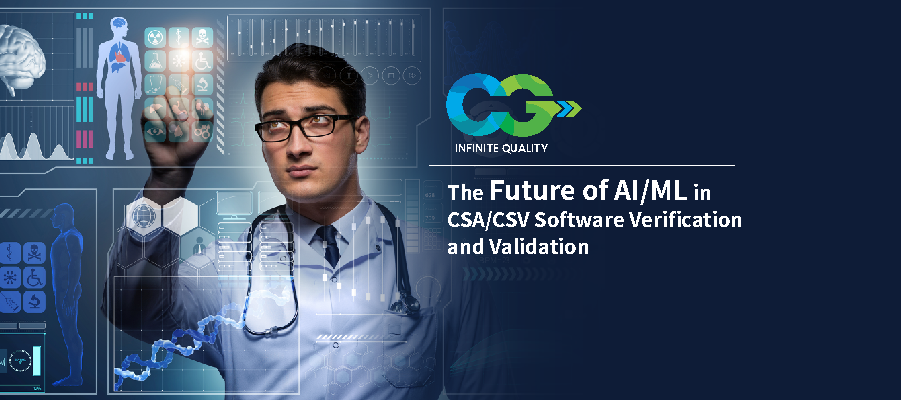The Future of AI/ML in CSA/CSV Software Verification and Validation

Article Context:
Development of AI/ML (Artificial Intelligence/Machine Learning) technologies has raised concerns regarding regulatory compliance. CSA/CSV (Computer Software Assurance / Computer System Validation) practices include high priority on ethical issues in AI/ML systems, such as transparency, privacy, and accountability. Robust verification and validation frameworks that show adherence to these standards will be necessary to ensure compliance with GDPR (General Data Protection Regulation) and industry-specific recommendations.
Integration of AI/ML technologies into crucial systems has increased the necessity of thorough verification and validation procedures. There is an increasing need to modify conventional methodologies in the fields of CSA / CSV for addressing challenges in AI/ML systems.
Software systems that use at least one AI component to perform certain functions, such as autonomous driving, image, and speech recognition, are known as AI-based systems. Because of advancements in AI, AI-based technologies are becoming a commonplace in society.
AI/ML Operational lifecycle
The AI/ML operational lifecycle refers to implementing and managing AI/ML models in a production environment, which involves a series of steps from data acquisition to monitoring and maintenance. We have discussed key stages of the AI/ML operational lifecycle here:
Planning and Data Acquisition: This is the initial stage. A qualified professional identifies relevant data sources; then gathers and pre-processes data that the intended system should use to ensure quality, integrity, and training for AI/ML models.
Model Development Stage: At this stage, once necessary data has been gathered and the objective is established, data scientists and ML engineers design and develop an AI/ML model using appropriate algorithms. The model then goes through several steps of internal and external validation, based on a subset of the data known as test data. The model can then be used to make predictions and produce fresh data sets.
Evaluation and Testing Stage: At this point, the accuracy, effectiveness, performance, and precision of the designed AI/ML model are carefully evaluated to identify potential errors and refinements or improvements.
Deployment, Monitoring and Maintenance: Once the model has been evaluated and verified, it is deployed in a production environment. Post-deployment, the model is monitored to detect performance degradation or data drift. Regular maintenance activities include updating data pipelines, addressing raised issues, and retraining the models using advanced algorithms.
CSA/CSV frameworks provide best practices for developing, evaluating, deploying, and maintaining software and systems which can be applied to the AL/ML operational lifecycle, to ensure reliability, security, safety, quality, and compliance throughout the process.
Implementing AI/ML in CSA/CSV
Implementing AI/ML (Artificial Intelligence/Machine Learning) in Computer Software Assurance (CSA) and Validation has numerous advantages that enhance the efficiency, effectiveness, and quality of software development and assurance processes. Here are some key advantages:
Requirements Analysis: ML algorithms assist in analysing and refining software requirements by analysing user feedback, usage patterns, and market trends. This ensures that the software meets user expectations and market demands.
Risk assessment: AI systems are capable of analysing system data to spot potential dangers and enable proactive risk mitigation. Software mitigation and implementation can automate this risk analysis.
Requirements Traceability: AI can keep track of the connections between tested systems and system requirements, ensuring that the criteria is met.
Test Automation: AI/ML can automate testing and validation of software applications by generating test cases, identifying edge cases, and simulating various user interactions. This leads to more thorough testing and faster identification of bugs and vulnerabilities.
Bug Detection and Resolution: ML algorithms can analyse code and identify potential bugs, security vulnerabilities, and performance bottlenecks. This helps developers address issues early in the development cycle.
Documentation Support: NLP (Natural Language Processing) -powered AI can generate and update software documentation, as well as provide user support through natural language interactions, enhancing user satisfaction.
Security Enhancement: AI/ML can identify and respond to security threats in real-time, such as malicious code or unauthorized access attempts. It can also assist in identifying behavioural patterns associated with cyberattacks.
Traceability Matrix: System requirements can be linked to test cases and verified systems using traceability matrices, which AI can create and maintain.
Automated Compliance Checks: AI can assist in ensuring that software adheres to relevant regulations and standards by analysing code and documentation for compliance.
Data-Driven insights for Development Strategy: AI can analyse data from software usage and performance to provide insights into user behaviour, helping development teams make informed decisions about feature enhancements and prioritization.
Continuous Validation: AI algorithms can perform constant evaluation of software systems, guaranteeing that they continue to function as intended over time.
Final Verdict
It's important to note that while AI/ML has the potential to bring about these outcomes, its success depends on factors such as data quality, model accuracy, proper implementation, and ongoing monitoring. Ethical considerations and the need for human expertise in software development and assurance remain crucial aspects of integrating AI/ML into CSA practices.
Planning to launch an AI/ML solution? With Compliance Group’s tech leaders holding patents in AI/Machine Learning and Distributed Computing, clients can be assured that all CSA/CSV solutions and AI/ML model implementations are backed by innovative AI/ML technology.
To take advantage of the opportunities offered by AI/ML and fully realize its potential in CSA/CSV software verification and validation, contact us at sales@complianceg.com
FAQ's
What are the guidelines for computer system validation?
Computer System Validation (CSV) is a critical process ensuring that computer systems used in regulated industries, such as pharmaceuticals, healthcare, and finance, meet required quality, regulatory, and compliance standards. While specific guidelines vary depending on the industry and regulatory body, here are some sources for general principles of Computer System Validation / Assurance:
- FDA (Food and Drug Administration): Provides guidance documents, regulations, and standards for various industries, including pharmaceuticals, medical devices, and biotechnology.
- GxP Guidelines: GxP refers to good practice guidelines for various industries, including GMP (Good Manufacturing Practice), GLP (Good Laboratory Practice), and GCP (Good Clinical Practice). These guidelines often contain principles for CSV/CSA.
- ISO Standards: ISO (International Organization for Standardization) establishes standards that may include principles for CSV. For instance, ISO 13485 (Medical devices – Quality management systems) and ISO 17025 (General requirements for the competence of testing and calibration laboratories) include aspects of CSV.
- ISPE (International Society for Pharmaceutical Engineering): ISPE provides industry guidance documents on topics related to pharmaceutical manufacturing. Their Guidance on “GAMP 5 – A Risk-Based Approach to Compliant GxP Computerized Systems” outlines principles and best practices for CSV.
What is Computer System Validation 21 CFR Part 11 standard?
The federal regulations outlined in 21 CFR Part 11 work to guarantee that electronic records are dependable, trustworthy, and legally equivalent to paper records and handwritten signatures.
